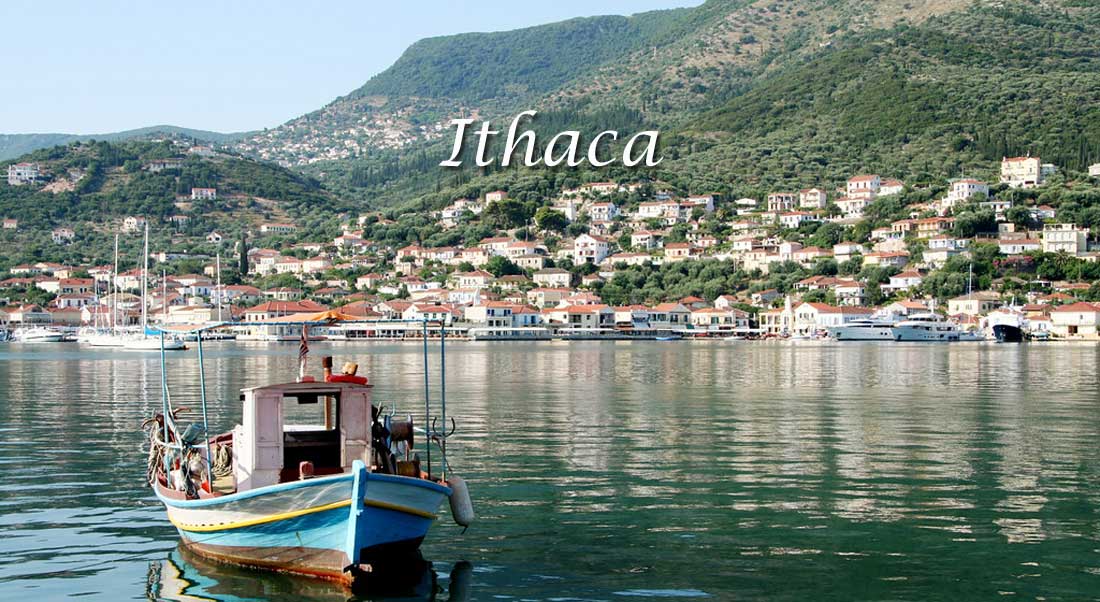Ithaca Greece holiday guide
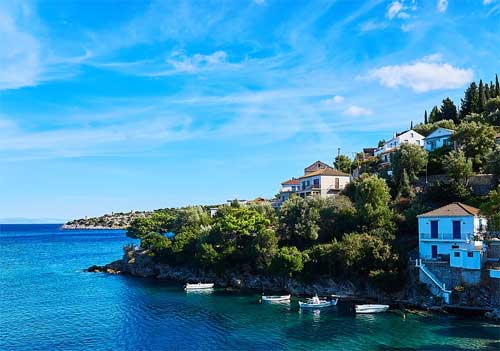
Much of Ithaca was destroyed by the earthquake in 1953 but it was faithfully rebuilt in the traditional style. Due to periods of Venetian, French, and British rule, the traditional style of architecture in Ithaca is best described as colonial.
There are three ports on the island: Frikes, Piso Aetos, and Vathi. Ferries from Lefkada arrive at Frikes, on the northern tip of the island. The tiny port of Piso Aetos has a ferry service to nearby Kefallonia. Vathi, the capital, handles the largest ferries and has frequent connections to Patra and to Sami on Kefallonia.
Frikes is a charming little fishing village with maybe a half-dozen buildings in all: two or three tavernas, a corner store, some rooms to rent, and a travel agent. Staying in Frikes you won’t be disturbed by the sounds of anything but the oceans waves lapping at the breakwater. The bus runs from Frikes to Vathi once a day, leaving from Frikes at 2:30 P.M. The road from Frikes continues along the coast 5 kilometers (3 miles) to the town of Kioni. In the other direction, the road heads to Vathi, 20 kilometers (12 miles) away. Vathi is a nice, small town. Its marina is filled with yachts and there is a nice square with many tavernas.
Being the island home of Odysseus, Ithaca has a surprising dearth of archaeological remains. There are a few spots on the island that are believed to be the ones mentioned in Homer’s Odyssey: Dexa beach is where the Phaeacians delivered Odysseus, the Cave of the Nymphs is where he stashed his treasure, and the Spring of Aretousa is where Odysseus met his swineherd dressed as a beggar. Dexa beach is in a small, well-protected bay only a few kilometers from Vathi. A large olive grove butts up against the pebble beach. There are a few places to stay here as well as a couple of tavernas. The Cave of the Nymphs is only 1 kilometer (0.5 miles) from Vathi.
Ithaca does not have much in the way of stunning beaches. The few beaches on the island are small and almost all of them are pebble or mixture of sand and pebble. The main beaches to visit are: Dexa, Filiatro, and several small beaches between Frikes and Kioni.
The people of Ithaca love cultural events. Each year they celebrate the Panhellenic Theater Competition in June and the Seminars on Homeric and Odyssean Literature each September. Every three years Ithaca is host to the International Odysseus Conference.
Small villages, a beautiful countryside, and short distances all combine to make Ithaca a worthy stop in your travels. Ithaca is truly a gem in the Ionian.
History and Mythology
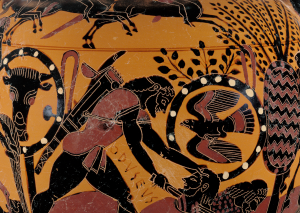
The island has probably been inhabited since the 2nd Millennium BC, and there is evidence it was the capital of Cephalonia during the Mycenaean period (around 1500BC). This coincides with the Trojan war, and if Odysseus really existed, now is when he would have been king.
The Romans occupied the island in the 2nd century BC, and later it became part of the Byzantine empire. It was constantly attacked by pirates, and made an alliance with Cephalonia in AD800.
The Normands and the Franks ruled Ithaca in the 12th and 13th century, and after a 30 year Turkish rule (1479-1499) it fell into Venetian hands.
Towards the end of the 18th century the island was occupied by the French, and in 1809 it was conquered by the British. In 1821 the war of Independence broke out, and Ithaca was finally liberated in 1864.
Much of the island was destroyed in the terrible earthquake of 1953. Therefore most of the buildings on the island are no older than 50 years, and the Italian influence is quite obvious.
What to See
Ithaca is about as laid-back of an island as there can be. Hiking through the rugged and beautiful hills is recommended. There is a decent hike to the Spring of Aretousa, where Odysseus met his swineherd in the Odyssey. One kilometer from Vathi is the Cave of the Nymphs. Beaches are not one of Ithaca’s highpoints. Most of the beaches are small and pebbly but at least you won’t find them packed with people like on some of the other islands.
Ithaca’s beautiful little capital Vathy has the worlds largest natural harbour. Here you can visit the cave of the nymphs, as well as the small archeo-logical museum.
Local artists have their own shops, and the many small cafes and taverns will impress you.
The monastery of the Virgin Mary (Panagia) Kathara is open for visitors.
It was probably built in the 16th or 17th century, and has very beautiful icons, as well as very nice surroundings. There are also some ancient ruins just outside Stavros.
Cave of Nymphs
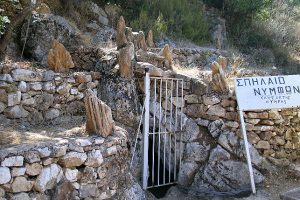
What treasures have been found are more of an archaeological nature and can be found in the museum in Vathy.
The cave is, well it’s a cave, and has a hole in the roof and a clump of cypress at the entrance. What atmosphere it once may have had have been lost in a blaze of tacky coloured lights. Some say this is not even the original cave anyway, the real one being inadvertently demolished in a nearby quarry some years ago. The route to the cave is well signposted from the road.
Folklore and Naval Museum of Ithaca
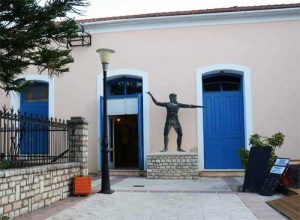
The primary purpose of the museum is to group and coordinate activities related to the conservation, development and dissemination of the cultural heritage of Ithaca. Indeed, this museum tries as much as possible to prevent vestiges from leaving the island, from being destroyed and also takes care of the storage as well as the preservation of objects testifying to human history, as well on land than at sea.
You can therefore find many traditional costumes of the island, everyday objects dating back several centuries, statues, furniture, tools, vases, photographs and much more.
Archaeological Museum of Ithaca
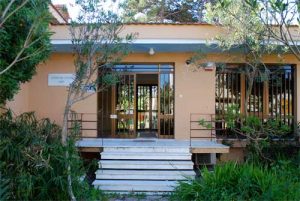
The new Museum started operating in 1972, while the re-exhibition works were completed in 1976.
The permanent exhibition of the Museum is due to P. Kalligas, at that time Curator of Antiquities of Corfu, to which Ithaca belonged archaeologically, following a topographic development in chronological order in three rooms.
The weight, however, is given to the important excavation of Southern Ithaca.
Monastery of Kathara
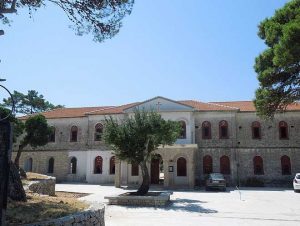
There is a hiking path to climb up to the monastery, its level of difficulty is not too high, but be aware that it is a hike on the side of hills, which still requires some preparation, and especially good hiking shoes.
Anyway, the detour is really worth it, not only for the monument that is the monastery, but also for the incredible view you will have from the top over the whole town of Vathy and the sea in the distance.
Spring of Arethousa
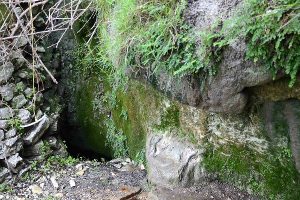
To get there follow the road out of Vathy that is signposted to the Marathis Plateau. At the village of Anemothouri, on the right, there is a large blue and white sign pointing to the Arethousa Fountain track. Follow the red waymarkers to the site which is little more than a cleft in the rock.
The scenery at the fountain is pretty impressive and a difficult rock-strewn descent down a ravine brings you to an unnamed beach opposite the islet of Perapigadia. The spring itself is little more than a dribble and many may wonder at the effort taken to get there.
The cave of Loïzos
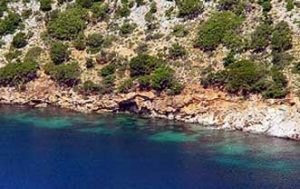
These rooms were in fact part of an ancient place of worship and adoration of the goddesses Artemis, goddess of wilderness, hunting and childbirth, Athena, goddess of wisdom and military strategy, Hera, goddess of marriage and fertility, and much more. There are still statues of these deities as well as some period objects related to worship, but also many coins.
Characteristic are the colorful stalactites that exist inside. During the excavations that took place, An ancient temple, vases as well as some tributes to the Nymphs and Odysseus came to light. Statues of deities such as Artemis, Athena and Hera were also found. An ivory statuette depicting Odysseus tied to a ship’s mast was also found.
Paleochora
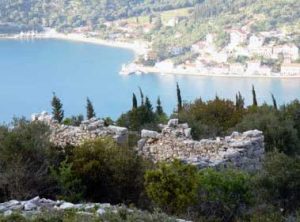
What is left of the village are the ruins of houses and churches which, although half-destroyed, still retain remarkable Byzantine hagiographies. The architecture of the settlement is interesting and shows a purely defensive character. The houses are one-storey or two-storey and without balconies.
Ancient Acropolis of Ithaca
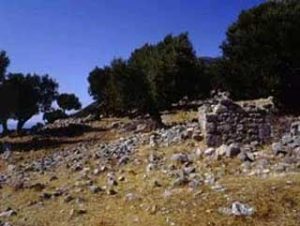
And of course, according to Schliemann, all the locals believe that these are the ruins of Odysseus’ palace.
The truth is that the identity of this Acropolis has not yet been clarified. It can also be the city of Alalkomena. It may even be the city of Ithaca of Aristotle.
There are still many attractions in the beautiful Sulfur. In our next walk we will meet some of them. We will be together again.
Ithaca towns and resorts
Vathy the capital
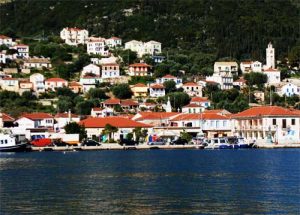
The wooded islet of Lazaretto sits in the bay where a hospital was built in 1668, used as a prison in 1864 then demolished by an earthquake in 1953. All that remains today are trees and a picturesque, whitewashed church.
Despite the lovely setting Vathi itself has a utilitarian quayside lined with functionally bland buildings that owe little to the pre-quake Venetian architecture.
A preservation order has prevented unsightly building and protection from naked commercial development but the results are dull, and not enhanced by a large car park on the Vathy quay.
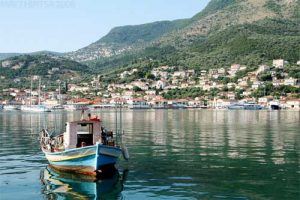
The Folklore and Cultural Museum of Ithaka is behind the Agricultural Bank and has good exhibits of island life as well as photographs of the devastating earthquake of 1953.
Vathy is where most amenities are found – post office, bank, cash machine, bakery, mini markets and so on. Ferries leave for mainland Greece, Kefalonia, Corfu and Italy while excursion boats offer round-island trips, a good bet given the poor state of many roads.
There are several out-of-town walks to sites that claim a mention in the Odyssey.
Kioni
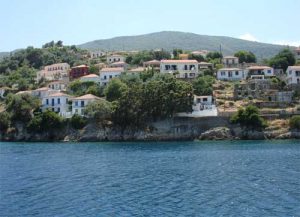
Well-heeled holidaymakers parade around the harbour before setting into one of several waterside bars and tavernas. Cars are banned from Kioni village over the summer.
Kioni is so cute it should be cheesy, but it somehow manages to marry authentic charm to the demands of tourism. This comes at a price, reflected in the opulent yachts moored in the bay.
Those who tire of tavernas can visit tiny coves at the mouth of the bay, windmills on the headland or walk donkey trails in the hills.
The beach sits below the windmills, a steep, short and narrow bank of pebble and shingle with overhanging trees at one end. A beach cantina opens in high summer.
Stavros
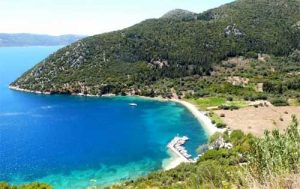
Stavros, which means crossroads, also envelops the hamlets of Pilicata and Kalyvia and acted as a ‘chora’ in the 16th century to avoid pirate attacks.
A stern and imposing bust of Odysseus stands in the shady central platia and the village has several traditional old houses that survived the 1953 Ithaka earthquake.
Stavros has several good tavernas and cafes as well as a mini-market. Worth a look are the fine churches of Sotiris, Agia Varvara and Zoodochos Pigi.
Spoils from excavations at the former Loizos Cave are displayed in the tiny village archaeological museum, which also has finds from the Early Hellenistic period to the Roman periods.
Perachori
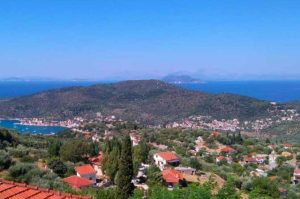
Small tavernas open in summer although Perachori is very much a working, not a tourist, village. The ruins of fortified houses show this was once used by the residents of Vathia to escape passing pirates.
Terraces tumble down hillsides planted with neat rows of vines and every almost turning reveals a small citrus orchard or vegetable plot. The area is also known for its organic produce.
Visitors get unobstructed views over the whole south of the island and the offshore islets Nearby is the Monastery of Taxiarchis built in 1645 near the top of the mountain.
Frikes
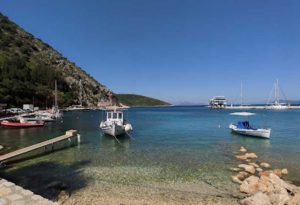
Though tarted up fin recent years Frikes retains plenty of Greek charm with cafes and tavernas are strung around a dainty harbour and a sleepy village luxuriantly planted with bougainvillea.
Streets are so narrow that a one system operates for traffic. Ferries from Lefkas arrive in the morning and Frikes is briefly busy with arrivals before settling back its sleepy ways.
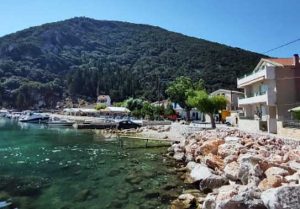
This is a good base to explore the island with splendid countryside walks along cleared coastal trails. The bay to the south offers a string of small coves and beaches, most of them easily accessible from the coast road.
The beaches are all much the same, small pebble and stone coves with no facilities. One of the best, and nearest to Frikes, is Kourvoulia, a narrow scoop of shingle along the roadside.
Piso Aetos
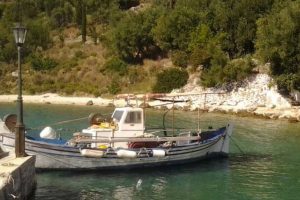
Some claim this as the castle of Odysseus although the evidence is pretty thin. A waymarked path from leads from Aetos starting just behind the chapel.
On the opposite side of the ridge from Aetos, and facing west with views across the strait to Kefalonia, is the small port of Piso Aetos.
More of a ferry port than a beach resort, the tiny harbour has been enlarged to take bigger ferries which usually avoid the long sail around to Vathy on the other side of the island.
A thin and narrow beach of rough pebbles lines the shore but few use it for bathing as it is barren and very exposed. A small cantina opens near the harbour in the summer months but there are no shops, toilets or other facilities.
Polis
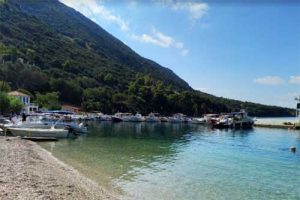
Polis lies below the main town of Stavros and, with parking on the beach, a taverna and plenty of sunbeds, it can get crowded.
Land behind is flat scrub so there is no shade. Tamarisks have been planted at the back of the beach but they are behind a fence.
A small harbour at the southern end has boat trips around Ithaka and to Fiscardo on Kefalonia. It was a ferry port before the expansion at Piso Aetos, just down the coast.
At the north end of the bay is the site of the former Loizos Cave where important religious artefacts were unearthed. Earthquakes have reclaimed it and the cave has collapsed.
Exoghi village
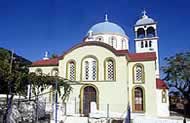
Many houses here may have fallen into disrepair but this is still a picturesque village in a picturesque spot with wonderful vistas down to Afales and over the sea.
Exoghi is noted for its three small pyramids built in 1933. The eccentric builder and his mother are buried under two of them.
The main village church of Agia Marina is well worth a visit and there is a small cafe here with rooms for rent.
What to do
You just Relax!!! Ithaca is also excellent for snorkelling and some people like to climb its mountains. The nature is steep and beautiful, and has a wide range of flora and fauna, so going for long walks is a good choice. Bring lots of water, though, and prepare for some serious climbing. There are water sports, tennis courts and daytrips to the neighbouring islands. In August there is a cultural festivals with artists and orchestras from all over the wor
If you don’t know what to do in Ithaca and want to spend a sports holiday in Ithaca, then go to Odyssey Outdoor Activities, a sports center specializing in outdoor activities in the region! This well-known center on the island is located in Vathy and offers many activities, both for beginners and for experienced athletes, such as:
In addition, the center has extended its activities and it is also possible to visit Ithaca in 4×4 and by boat, to carry out guided tours focusing on the history of the city of Vathy as well as of the whole island, but also participate in group photography projects.
You were wondering what to do in Ithaca after seeing and doing the essentials mentioned above? Be aware that there are still a few points of interest that you can see while you are visiting Ithaca:
Where to stay
Ithaca is only a small island and holiday accommodation is mostly limited to the main port of Vathy. There are plenty of places to stay around Vathy, from cheaper budget rooms to luxury villas with swimming pools and sea views.
There are also many small houses, apartments and villas to rent but this is not a place to turn up in the main holiday season of July and August when the small island can become quite crowded.
Frikes is the most northerly of Ithaca’s village resorts and there are usually rooms to be found out of the main season and a few rooms are on offer in nearby Stavros, which has the largest population.
Most tourists visiting north Ithaca stay in Kioni but accommodation there will need to be booked well in advance. There are a rooms and studios in other parts of north Ithaca, such as at Lefki and at Agios Yiannis beach. In the south there is Vathy, which takes the highest numbers, but other accommodation is dotted along the coastline.
The hill village of Perahori commands the best views and rooms can usually be found except during the local festival. Perahorihas an agrotourism project which offers rooms in local houses as part of the family.
Ithaca beaches
Aetos beach
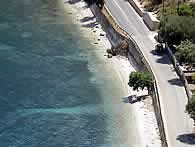
Despite its proximity to Vathy and a road behind providing easy access Aetos is often strewn with rubbish and detritus, either washed up on the waves or flung from the windows of passing cars.
The road runs behind Aetos beach for about a kilometre atop a high cement wall. The occasional tamarisk provides shade but it the beach is generally very exposed.
A forest fire that scarred much of the Aetos hillside is slowly reverting to its natural state.
Agios Ioannis
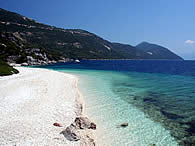
Getting down to the shore is a problem, particularly if a descent is attempted before reaching the village of Lefki. There is dirt track but it’s a precipitous drop.
Even the road from Lefki is difficult, with hairpin turns on a steep track that ends about 100 metres from the beach. A steeper path then leads down past the windmill.
Visitors will find a long narrow strip of pebble and stone with fine views across the straits but there is no shade and no facilities.
Afales
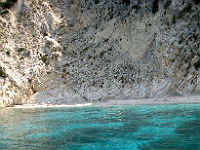
Remote and relatively inaccessible it is rarely visited except in the high season. Those that venture here do so by boat and as the descent on foot is suicidally dangerous.
Visitors may be disappointed as this north-facing beach of stone and pebble tends to collect its fair share of detritus. There is no shade and there are no facilities here. It may even feel a little claustrophobic beneath the looming cliff.
Over the headland and about four kilometres from Afales is a stone beach at Marmakes reached along a dirt rough dirt track.
Marmaka beach
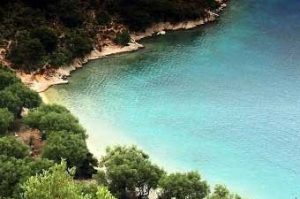
There are moves afoot to improve the road which may open it up to more visitors. The stone beach is very attractive, with an offshore islet sporting a tiny chapel to add romance to the setting.
Trees line the shore and there are walks through the groves of olive and citrus behind. There are no facilities here but that may change when the road improves.
Skinos beach
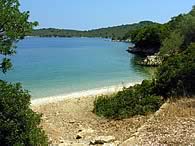
Skinos is approached down a dirt track and the pebble and stone beach seems to attract a good share of tidal rubbish that, being in such an isolated spot, rarely gets a clean-up.
The beach is very narrow and backed by a low stone wall and offers good snorkelling along the rocky shore. A pleasant place to hide away Skinos has shade from tall cypress trees but has no facilities.
Sarakiniko beach
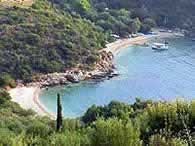
One of the Sarakiniko beaches is dominated by a cement villa and it’s also used to launch boats from a slipway so serious bits of boat rubbish can be strewn around.
The other option is a quiet, attractive beach in a sheltered bay. Olives and cypress provide shade but there are no facilities here.
The steep bank of pebbles can be uncomfortable to lie on but nearby sandstone slabs provide a good alternative.
There was once a German ‘commune’ at Sarakiniko than numbered about 200 people but only a handful live there now.
Dexa
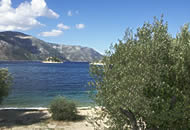
Dexa is about two kilometres from Vathy so it’s a popular spot for those staying in the island capital. A fair number of apartments have also been built here so Dexa tends to get fill rather early in the day.
The very narrow strand of pebble is backed by a low wall and there are clutches of tamarisk as well as olive trees where visitors can relax on shaded sunbeds. A small cantina opens in the summer.
At the southern end the road curves round to a small anchorage. Car parking can be a problem on the narrow road and a desalination plant nearby can, if the wind is right, produce an irritating hum.
Overlooking the bay at nearby at Loutsa are the ruins of a French fort built in 1805 where narrow tracks lead to even quieter.
Filiatro
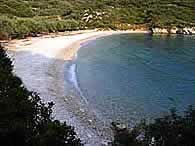
The water is shallow but footwear is recommended as the beach of pebble and stone has no sand under the water. Chairs and tables are set out under shady trees.
Car access is good from the road east out of Vathy. Olive trees and tamarisk provide good shade and there is a small campsite nearby.
Nightlife
Ithaca is an island for relaxing but if you want some nighlife, there are two discos in Vathy. Otherwise, you can enjoy some very nice little bars and cafes with a romantic atmosphere in the evenings. The nightlife on the island is not very lively, only in the capital is it possible to find some clubs, taverns or small restaurants where you can spend the evenings.
Ithaca, unlike many other Greek islands, does not have a very intense nightlife, travelers will find more than anything else a place rich in history, mythology and a spectacular sea, typical of Greece. This does not mean, however, that nocturnal entertainment is totally absent, after a day at the beach you can go to the marinas of Frikes and Kioni where you will find restaurants, bars and typical shops. If you are looking for something more lively, Vathi, the capital, is the best place to find places to dance the night away, ideal for young people.
Food
The local taverns serve mostly good, traditional Greek food. Most of the local specialties are based on fish, and there are some sweets that are worth a try. In Ithaca you will find typical Greek cuisine, rich in Mediterranean flavors.
As soon as you sit down in one of the island’s characteristic taverns, you will certainly be tempted to try mezedes, the typical local appetizer, but this will only be the beginning. In fact, the island offers numerous dishes based on both meat and fish, such as tzatziki, but among the many courses you can taste, try the typical Greek salad, cheeses and their world-famous yogurt.
Drosia tavern, has a beautiful view, tables in a beautiful garden outside and Greek cuisine with lots of fish. Then the grill restaurant O Zois is good, typical cuisine, nice toast and a lot of meat: it is always full! above all the penelope restaurant because first of all it has a romantic atmosphere and then you eat very well fresh fish , more Greek dishes from the hinterland and a wine list that amazes!
Weather in Ithaca
Like all Ionian islands Ithaka has long, hot and dry summers and mild, very wet winters. Summers can be very warm, reaching 30°C in August, and humid as the Ionians escape the brisk northern ‘meltemi’ winds that sweep many Greek islands. The sea stays warm right through to November.
Winter rains are heavy, helping to keep the island green int he summer. The western Ionian islands can get three times the winter rainfall of other Greek islands. Winter temperatures may drop to lows of 9°C but usually hover around the 13°C .
Getting Around
There is a bus connecting Vathy, Frikes and Kioni. Because the island is so mountainous, many find the bustrip horrific, since the roads are quite narrow and winding. There are also smaller boats that can take you around the island. A few taxis work, and you can rent a moped.
Getting there
By ferry
With a large natural harbour at Vathi and other small port at Piso Aetos and Frikes, Ithaka is served by a remarkable number of ferry connections given its small size.
Kefalonian Lines operates services between Ithaka, Sami on Kefalonia, the mainland port of Killini and Zakynthos with outward sailings from Ithaka on Monday, Friday and Saturday and imward journeys on Thursday, Friday and Sunday.
The West Ferry Maritime Company also adds Ithaka on its Lefkas to Kefalonia service in the summer on its ‘Captain Aristidis’ ferry.
The Ionio Pelagos runs a daily service between Vassiliki on Lefkas, Sami on Kefalonia, and mainland Astakos calling in at the port of Piso Aetos on Ithaka on the way.
The ferry boat Meganissi, run by Coastal Lines Ionios, runs daily between Nidri on Lefkas and the small port of Frikes on Ithaka.
There are daily sailings between mainland Patras by Strintzis Ferries calling at Sami and Vathy.
Also based at Vathy on ithaka is the Odysseas Sea Taxi (+30 26740 33581) which picks up and drops off at ports all over the Ionian.
By air
There is no airport on Ithaka and most visitors fly to Kefalonia Airport (EFL) which has daily domestic flights from Athens as well as charter flights from all over Europe.
Unfortunately, most ferries to Ithaka are from the port of Sami, on the other side of the island. Flight and ferry times rarely coincide so an overnight stay on Kefalonia is often needed either in Argostoli or in Sami.
It is also possible to fly to Preveza/Aktion Airport (PVK) on the mainland and drive south to the port of Astakos which has ferry connections to Ithaka. The same problems with flight ferry connections apply so flight to Kefalonia are probably the best option.
Yet another alternative is a flight to Zante Airport and a ferry to Ithaka via Killini and Kefalonia.
